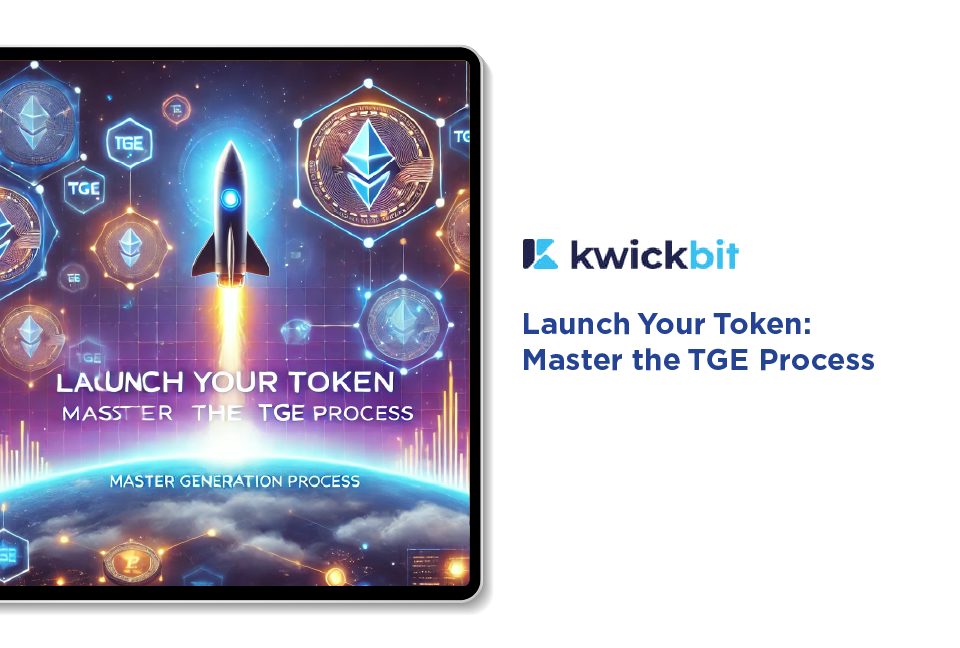Token Generation Events (TGEs) have revolutionized fundraising by enabling blockchain projects to sell their native tokens directly to investors. If you’re exploring how to create a token and conduct a successful TGE, this guide will walk you through each step—from token creation to post-TGE strategies. Uncover insights with KwickBit!
What Is a Token?
A token is a digital representation of an asset or utility residing on a blockchain. Unlike cryptocurrencies like Bitcoin or Ethereum, which have their own native blockchains, tokens are created on existing platforms such as Ethereum, Binance Smart Chain, or Solana. Tokens can:
- Represent digital assets like NFTs (Non-Fungible Tokens).
- Provide utility within a specific ecosystem (e.g., access to services, governance rights).
- Be used for fundraising through TGEs.
Understanding Token Generation Events (TGEs)
A Token Generation Event (TGE) is a fundraising mechanism where blockchain-based projects offer their native tokens to the public. Similar to an Initial Public Offering (IPO), TGEs raise funds by selling tokens. However, TGEs focus on the future potential of a project rather than its past performance.
Key Features of TGEs:
- Tokens can grant utility, voting rights, or revenue shares within the project’s ecosystem.
- They are created on existing blockchains like Ethereum or Binance Smart Chain.
- TGEs enable decentralized, global fundraising, eliminating traditional intermediaries.
Steps to Successfully Launch a Token Generation Event
Step 1: Develop a Product or Service
Before initiating a TGE, ensure you have a viable product or service that the token will support. Conduct thorough market research to identify a real-world problem your product can solve. Engage potential users to gather feedback and refine your offering.
Pro Tip: Consult a blockchain advisor to ensure your product aligns with blockchain technology and industry trends.
Step 2: Create Your Token
The next step is to create your token on a blockchain platform like Ethereum (ERC-20) or Binance Smart Chain (BEP-20). Ensure your token has clear utility within your ecosystem.
Key Considerations for Token Creation:
- Use established standards like ERC-20 or BEP-20 for compatibility and ease of integration.
- Clearly define tokenomics, including total supply, distribution, and any rewards or burn mechanisms.
Resources for Developers:
Step 3: Address Legal Considerations
Cryptocurrency regulations vary by country, so seek legal advice to structure your TGE in compliance with applicable laws. This includes registering your token if necessary and ensuring investor protections.
Checklist for Legal Compliance:
- Conduct a thorough review of securities laws in your jurisdiction.
- Create clear terms and conditions for participants.
- Obtain legal opinions if required.
Step 4: Craft a Detailed Whitepaper
Your whitepaper is the backbone of your TGE, detailing your project’s purpose, technical framework, tokenomics, and team. It serves as both a roadmap and a marketing tool.
Tips for a Winning Whitepaper:
- Use clear, concise language to explain technical concepts.
- Include visuals like flowcharts and graphs to simplify complex ideas.
- Highlight the problem your project solves and its long-term vision.
Step 5: Build a Strong Community
A supportive community is crucial for TGE success. Leverage social platforms like Discord, Telegram, and Twitter to engage potential investors and supporters. Share updates, host AMAs (Ask Me Anything), and encourage feedback.
Tools for Community Building:
Step 6: Launch an Effective Marketing Campaign
Effective marketing ensures your TGE reaches the right audience. Utilize a mix of strategies:
- Social Media Campaigns: Create engaging content for Twitter, LinkedIn, and YouTube.
- Influencer Collaborations: Partner with crypto influencers to amplify your reach.
- Press Releases: Announce your TGE on platforms like CoinDesk or CoinTelegraph.
SEO Tip: Optimize your project website with relevant keywords like “Token Generation Event” and “blockchain fundraising.”
Step 7: List Your Token on Exchanges
Listing your token on reputable cryptocurrency exchanges boosts visibility and liquidity. Consider both centralized exchanges (e.g., Binance, Coinbase) and decentralized exchanges (e.g., Uniswap, PancakeSwap).
Steps for Token Listing:
- Research exchange listing requirements.
- Submit necessary documentation and comply with their due diligence process.
- Promote the listing to your community.
Step 8: Post-TGE Actions
After the TGE, focus on maintaining momentum:
- Deliver on promises outlined in the whitepaper.
- Share regular project updates to keep the community engaged.
- Monitor token performance and adapt your strategy as needed.
Step 9: Evaluate TGE Success
Analyze the success of your TGE by tracking metrics such as:
- Total funds raised.
- Number of participants.
- Token’s market performance.
- Community engagement and feedback.
Use these insights to plan the next stages of your project.
Common Challenges in TGEs and How to Overcome Them

Challenge 1: Regulatory Uncertainty
- Solution: Stay updated on global crypto regulations and seek professional legal advice.
Challenge 2: Building Trust
- Solution: Conduct smart contract audits and maintain transparency with investors.
Challenge 3: Marketing Effectiveness
- Solution: Collaborate with industry influencers and monitor analytics to refine campaigns.
Conclusion
So now you’ve reviewed about Launch Your Token: Master the TGE Process. KwickBit hopes this article will provide you with more useful information.
Token Generation Events are powerful tools for blockchain projects to raise funds and build engaged communities. By following this comprehensive guide—from product development to post-TGE evaluation—you can navigate the complexities of TGEs and position your project for long-term success.
Remember, success lies in careful planning, compliance with regulations, and fostering trust within your community. Start your TGE journey today and make your mark in the blockchain world!
KwickBit – Non-custodial Payment Gateway
Read more:
